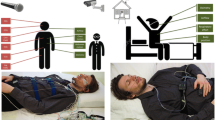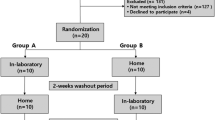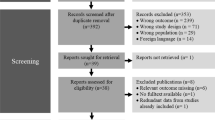Abstract
Purpose
The objective of the study is to test the hypothesis that a level 2 portable sleep device (Embletta X100) is a reliable alternative for standard PSG in surgical patients.
Methods
After hospital ethics approvals, preoperative patients over 18 years old were recruited. The patients for validation underwent standard PSG and Embletta X100 simultaneously in a sleep laboratory before surgery. The other patients received sleep studies with Embletta X100 perioperatively. The correlation analysis and paired Student t test between variables from Embletta and from standard PSG were used to evaluate the accuracy of Embletta. The quality of PSG recordings with Embletta was summarized.
Result
Twenty-one patients completed sleep study on both systems; ten females and ten males, age was 54 ± 11 and BMI was 36 ± 9. There was a significant correlation between the majority of parameters from standard PSG and Embeltta X100 with manual scoring. The inter-rater agreement was substantial to perfect at different AHI cutoffs with a Kappa coefficient of 0.69 to 1. A significant correlation between standard PSG and Embletta X100 with automatic scoring was found only in AHI and a few other parameters. In 385 patients, 1,002 perioperative PSG recordings were carried out with Embletta. Of them, 889(88.7%) were technically good and 90(9%) technically acceptable. Only 23 (2.3%) PSG recordings failed.
Conclusion
Embletta X100, installed by a well-trained sleep technician, is a good alternative when standard PSG was not available or impractical. Manual scoring by a certified PSG technologist is the key for reliable results.


Similar content being viewed by others
References
(1999) Sleep-related breathing disorders in adults: recommendations for syndrome definition and measurement techniques in clinical research. The Report of an American Academy of Sleep Medicine Task Force. Sleep 22:667-689
Bixler EO, Vgontzas AN, Ten HT, Tyson K, Kales A (1998) Effects of age on sleep apnea in men: I. Prevalence and severity. Am J Respir Crit Care Med 157:144–148
Bixler EO, Vgontzas AN, Lin HM, Ten HT, Rein J, Vela-Bueno A, Kales A (2001) Prevalence of sleep-disordered breathing in women: effects of gender. Am J Respir Crit Care Med 163:608–613
Young T, Evans L, Finn L, Palta M (1997) Estimation of the clinically diagnosed proportion of sleep apnea syndrome in middle-aged men and women. Sleep 20:705–706
Bresnitz EA, Goldberg R, Kosinski RM (1994) Epidemiology of obstructive sleep apnea. Epidemiol Rev 16:210–227
Simonds AK (1994) Sleep studies of respiratory function and home respiratory support. BMJ 309:35–40
Hung J, Whitford EG, Parsons RW, Hillman DR (1990) Association of sleep-apnea with myocardial-infarction in men. Lancet 336:261–264
Doherty LS, Kiely JL, Swan V, McNicholas WT (2005) Long-term effects of nasal continuous positive airway pressure therapy on cardiovascular outcomes in sleep apnea syndrome. Chest 127:2076–2084
Leung RS, Bradley TD (2001) Sleep apnea and cardiovascular disease. Am J Respir Crit Care Med 164:2147–2165
Moruzzi P, Sarzi-Braga S, Rossi M, Contini M (1999) Sleep apnoea in ischaemic heart disease: differences between acute and chronic coronary syndromes. Heart 82:343–347
Schafer H, Koehler U, Ploch T, Peter JH (1997) Sleep-related myocardial ischemia and sleep structure in patients with obstructive sleep apnea and coronary heart disease. Chest 111:387–393
Young T, Finn L, Peppard PE, Szklo-Coxe M, Austin D, Nieto FJ, Stubbs R, Hla KM (2008) Sleep disordered breathing and mortality: eighteen-year follow-up of the Wisconsin sleep cohort. Sleep 31:1071–1078
(1997) Practice parameters for the indications for polysomnography and related procedures. Polysomnography Task Force, American Sleep Disorders Association Standards of Practice Committee. Sleep 20:406-422
Flemons WW, Douglas NJ, Kuna ST, Rodenstein DO, Wheatley J (2004) Access to diagnosis and treatment of patients with suspected sleep apnea. Am J Respir Crit Care Med 169:668–672
Santos-Silva R, Sartori DE, Truksinas V, Truksinas E, Alonso FF, Tufik S, Bittencourt LR (2009) Validation of a portable monitoring system for the diagnosis of obstructive sleep apnea syndrome. Sleep 32:629–636
Yin M, Miyazaki S, Ishikawa K (2006) Evaluation of type 3 portable monitoring in unattended home setting for suspected sleep apnea: factors that may affect its accuracy. Otolaryngol Head Neck Surg 134:204–209
Popovic D, King C, Guerrero M, Levendowski DJ, Henninger D, Westbrook PR (2009) Validation of forehead venous pressure as a measure of respiratory effort for the diagnosis of sleep apnea. J Clin Monit Comput 23:1–10
Westbrook PR, Levendowski DJ, Cvetinovic M, Zavora T, Velimirovic V, Henninger D, Nicholson D (2005) Description and validation of the apnea risk evaluation system: a novel method to diagnose sleep apnea-hypopnea in the home. Chest 128:2166–2175
Hedner J, Pillar G, Pittman SD, Zou D, Grote L, White DP (2004) A novel adaptive wrist actigraphy algorithm for sleep-wake assessment in sleep apnea patients. Sleep 27:1560–1566
Ayas NT, Pittman S, MacDonald M, White DP (2003) Assessment of a wrist-worn device in the detection of obstructive sleep apnea. Sleep Med 4:435–442
Collop NA, Anderson WM, Boehlecke B, Claman D, Goldberg R, Gottlieb DJ, Hudgel D, Sateia M, Schwab R (2007) Clinical guidelines for the use of unattended portable monitors in the diagnosis of obstructive sleep apnea in adult patients. Portable monitoring task force of the American academy of sleep medicine. J Clin Sleep Med 3:737–747
Tiihonen P, Hukkanen T, Tuomilehto H, Mervaala E, Toyras J (2009) Evaluation of a novel ambulatory device for screening of sleep apnea. Telemed J E Health 15:283–289
Bridevaux PO, Fitting JW, Fellrath JM, Aubert JD (2007) Inter-observer agreement on apnoea hypopnoea index using portable monitoring of respiratory parameters. Swiss Med Wkly 137:602–607
Dingli K, Coleman EL, Vennelle M, Finch SP, Wraith PK, Mackay TW, Douglas NJ (2003) Evaluation of a portable device for diagnosing the sleep apnoea/hypopnoea syndrome. Eur Respir J 21:253–259
Littner MR (2005) Portable monitoring in the diagnosis of the obstructive sleep apnea syndrome. Semin Respir Crit Care Med 26:56–67
Endeshaw YW, White WB, Kutner M, Ouslander JG, Bliwise DL (2009) Sleep-disordered breathing and 24-hour blood pressure pattern among older adults. J Gerontol A Biol Sci Med Sci 64:280–285
Ruberto M, Caputi M, Fiorentino G, Vessella W, Liotti F (2007) Obstructive sleep apnea syndrome (OSAS) and work. G Ital Med Lav Ergon 29:836–838
Smith LA, Chong DW, Vennelle M, Denvir MA, Newby DE, Douglas NJ (2007) Diagnosis of sleep-disordered breathing in patients with chronic heart failure: evaluation of a portable limited sleep study system. J Sleep Res 16:428–435
Zvartau NE, Conrady AO, Sviryaev YV, Rotari OP, Merkulova NK, Kalinkin AL, Shlyakhto EV, Bagrov AY (2006) Marinobufagenin in hypertensive patients with obstructive sleep apnea. Cell Mol Biol (Noisy-le-grand) 52:24–27
Abdelghani A, Roisman G, Escourrou P (2007) Evaluation of a home respiratory polygraphy system in the diagnosis of the obstructive sleep apnea syndrome. Rev Mal Respir 24:331–338
Oldenburg O, Lamp B, Faber L, Teschler H, Horstkotte D, Topfer V (2007) Sleep-disordered breathing in patients with symptomatic heart failure: a contemporary study of prevalence in and characteristics of 700 patients. Eur J Heart Fail 9:251–257
Shen QB, Xu DL, Lin S, Lai WY (2006) Sleep-disordered breathing and left ventricular remodeling in patients with chronic heart failure. Nan Fang Yi Ke Da Xue Xue Bao 26:486–489
Endeshaw YW, Katz S, Ouslander JG, Bliwise DL (2004) Association of denture use with sleep-disordered breathing among older adults. J Public Health Dent 64:181–183
Gupta RM, Parvizi J, Hanssen AD, Gay PC (2001) Postoperative complications in patients with obstructive sleep apnea syndrome undergoing hip or knee replacement: a case-control study. Mayo Clin Proc 76:897–905
Chung F, Yegneswaran B, Liao P, Chung SA, Vairavanathan S, Islam S, Khajehdehi A, Shapiro CM (2008) Validation of Berlin questionnaire and ASA checklist as screening tools for obstructive sleep apnea in surgical patients. Anesthesiology 108:822–830
Hwang D, Shakir N, Limann B, Sison C, Kalra S, Shulman L, De Corla SA, Greenberg H (2008) Association of sleep-disordered breathing with postoperative complications. Chest 133:1128–1134
Liao P, Yegneswaran B, Vairavanathan S, Zilberman P, Chung F (2009) Postoperative complications in patients with obstructive sleep apnea: a retrospective matched cohort study. Can J Anaesth 56:819–828
Gross JB, Bachenberg KL, Benumof JL, Caplan RA, Connis RT, Cote CJ, Nickinovich DG, Prachand V, Ward DS, Weaver EM, Ydens L, Yu S (2006) Practice guidelines for the perioperative management of patients with obstructive sleep apnea: a report by the American Society of Anesthesiologists Task Force on Perioperative Management of patients with obstructive sleep apnea. Anesthesiology 104:1081–1093
Chung F, Yegneswaran B, Liao P, Chung SA, Vairavanathan S, Islam S, Khajehdehi A, Shapiro CM (2008) STOP questionnaire a tool to screen obstructive sleep apnea. Anesthesiology 108:812–821
Iber C, Ancoli-Israel S, Chesson A Jr, Quan S The AASM Manual for the Scoring of Sleep and Associated Events: Rules, Terminology and Technical Specification
Ayappa I, Norman RG, Seelall V, Rapoport DM (2008) Validation of a self-applied unattended monitor for sleep disordered breathing. J Clin Sleep Med 4:26–37
Dingli K, Coleman EL, Vennelle M, Finch SP, Wraith PK, Mackay TW, Douglas NJ (2003) Evaluation of a portable device for diagnosing the sleep apnoea/hypopnoea syndrome. Eur Respir J 21:253–259
Collop NA (2002) Scoring variability between polysomnography technologists in different sleep laboratories. Sleep Med 3:43–47
Snoey ER, Housset B, Guyon P, ElHaddad S, Valty J, Hericord P (1994) Analysis of emergency department interpretation of electrocardiograms. J Accid Emerg Med 11:149–153
Author information
Authors and Affiliations
Corresponding author
Additional information
Sources of financial support for the work (including institutional support)
University Health Network Foundation, Physician Services Incorporated Foundation, ResMed Foundation, and Respironic Foundation. University of Toronto for Dr. Chung and Dr. Shapiro.
Appendix 1 Sample of Sleep Diary
Appendix 1 Sample of Sleep Diary
Sleep Diary
Name _____________________ PSG ID____________
Op Date _______________ PSG Date ______________
Regular Bed Time___________
_____________________________________________
_______________________________________________
CPAP: Yes/No Oxygen Therapy: Yes/No
Bedtime (Lights Off):
Wash Room Time:
Wakeup Time in morning (Lights On):
Did you have a good sleep last night? Yes / No
Did any unusual thing happen last night? Yes / No
If yes, please provide some detail:
Comments:
_____________________________________________
_______________________________________________
_______________________________________________
_______________________________________________
_______________________________________________
_______________________________________________
_______________________________________________
_______________________________________________
_______________________________________________
_______________________________________________
_______________________________________________
_______________________________________________
_______________________________________________
_______________________________________________
_______________________________________________
_______________________________________________
_______________________________________________
_______________________________________________
_______________________________________________
_______________________________________________
Embletta No: Proxy No:
PSG Technician’s Comments:
Rights and permissions
About this article
Cite this article
Chung, F., Liao, P., Sun, Y. et al. Perioperative practical experiences in using a level 2 portable polysomnography. Sleep Breath 15, 367–375 (2011). https://doi.org/10.1007/s11325-010-0340-9
Received:
Accepted:
Published:
Issue Date:
DOI: https://doi.org/10.1007/s11325-010-0340-9




